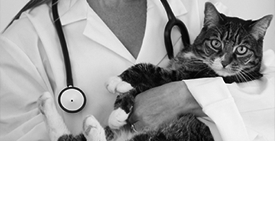Library
-
Enteropathy means any disease of the intestinal system. Protein-losing enteropathy (PLE) is not a specific disease but a group of diseases that cause the loss of proteins from the bloodstream into the gastrointestinal (GI) tract. Symptoms include diarrhea, weight loss, and fluid buildup in areas of the body. Treatment and prognosis are determined by the underlying cause.
-
Pulmonary hypertension means that the peak blood pressure in the arteries of the lungs is much higher than normal. Several abnormalities can lead to high blood pressure in the arteries of the lungs and many of the underlying reasons involve the heart. There are many signs of pulmonary hypertension including exercise intolerance, difficulty breathing with or without exertion/exercise, rapid breathing, coughing, spitting up blood from the lungs, fainting, and more. There are many potential causes of pulmonary hypertension. Several medications are available to treat your cat. Activity may need to be restricted. It is essential to monitor cats with pulmonary hypertension for worsening of clinical signs. Periodic physical examinations, blood pressure monitoring, and ultrasound evaluations of the heart are also important. The long-term prognosis is very guarded for cats with pulmonary hypertension.
-
Pulmonary thromboembolism describes a condition in which a blood clot lodges in one of the pulmonary arteries, blocking blood flow into the portion of the lung served by that artery. The signs of pulmonary thromboembolism include sudden difficulty breathing, rapid breathing, decreased appetite, fainting, coughing, spitting up blood, weakness, exercise intolerance, and the inability to get comfortable. Sudden death is possible. This article discusses potential causes, treatment, and prognosis.
-
Pyelonephritis is an upper urinary tract infection involving the kidneys and ureters. Many cats have no clinical signs when they have pyelonephritis, although they may have signs of lower urinary tract disease. Pyelonephritis is usually caused by a bacterial infection that moves up the urinary tract from the bladder to the kidneys. Cats with sudden pyelonephritis do well and return to normal health unless concurrent complications exist.
-
Pyometra is a serious and life-threatening infection in the uterus, occurring in female cats who have not been spayed. The condition must be treated quickly and aggressively. The preferred treatment is to surgically remove the uterus and ovaries by performing an ovariohysterectomy. There is a medical approach to treating pyometra, although the success rate is highly variable and not without considerable risk and potential long-term complications.
-
Pyothorax is the presence of inflammatory fluid or pus within the chest cavity, which is the area between the lungs and the inner walls of the ribs. Signs of pyothorax include rapid, shallow, open-mouthed breathing that may be painful, depression, lethargy, decreased appetite. Clinical examination by a veterinarian, particularly listening to the chest with a stethoscope, may indicate fluid in the chest.
-
Cryptorchidism is the failure of one or both testicles to descend into the scrotum. Risks of retained testicles include testicular cancer, spermatic cord torsion, and the development of undesirable male characteristics, so neutering is strongly recommended.
-
Retinal detachment can cause sudden blindness or vision changes. It is generally secondary to an underlying condition like high blood pressure. Diagnostics and treatment are discussed. Prognosis is guarded to good depending on the underlying cause.
-
Ringworm infections in cats are caused by a fungus, not a worm. They can be easily recognized, though definitive testing by fungal culture is recommended. Ringworm is highly contagious and can be spread between animals and from animals to people. The clinical signs, diagnosis, treatment, and risks are explained in this handout.
-
A salivary mucocele is an accumulation of saliva that has leaked from an injured salivary gland or duct. Some mucoceles cause swelling of the face and neck, while others interfere with a dog's ability to swallow or breathe normally. Treatment typically requires surgical removal of the affected salivary gland(s).


